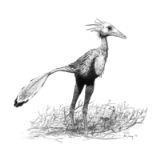
Sinornithoides
Encyclopedia
Sinornithoides is a genus
of troodontid theropod dinosaur
. It lived during the Early Cretaceous
(Barremian
stage
, around 130 125 million years ago). It measured approximately 1 meter
long (3 ft). It lived in Inner Mongolia
, China
, and probably ate invertebrates and other small prey.
Sinornithoides youngi, the type species
, was described in 1993 by Dale Russell
and Dong Zhiming
based on a fossil specimen from the Ejinhoro Formation
. It is represented by a holotype
which is articulated and nearly complete except for the roof of the skull and the cervical and dorsal vertebrae, along with some other referred skeletal elements. The holotype is preserved in much the same roosting position as another troodontid fossil, that of Mei long
, with its snout tucked under its left hand.
Genus
In biology, a genus is a low-level taxonomic rank used in the biological classification of living and fossil organisms, which is an example of definition by genus and differentia...
of troodontid theropod dinosaur
Dinosaur
Dinosaurs are a diverse group of animals of the clade and superorder Dinosauria. They were the dominant terrestrial vertebrates for over 160 million years, from the late Triassic period until the end of the Cretaceous , when the Cretaceous–Paleogene extinction event led to the extinction of...
. It lived during the Early Cretaceous
Cretaceous
The Cretaceous , derived from the Latin "creta" , usually abbreviated K for its German translation Kreide , is a geologic period and system from circa to million years ago. In the geologic timescale, the Cretaceous follows the Jurassic period and is followed by the Paleogene period of the...
(Barremian
Barremian
The Barremian is an age in the geologic timescale between 130.0 ± 1.5 Ma and 125.0 ± 1.0 Ma). It is a subdivision of the Early Cretaceous epoch...
stage
Faunal stage
In chronostratigraphy, a stage is a succession of rock strata laid down in a single age on the geologic timescale, which usually represents millions of years of deposition. A given stage of rock and the corresponding age of time will by convention have the same name, and the same boundaries.Rock...
, around 130 125 million years ago). It measured approximately 1 meter
Metre
The metre , symbol m, is the base unit of length in the International System of Units . Originally intended to be one ten-millionth of the distance from the Earth's equator to the North Pole , its definition has been periodically refined to reflect growing knowledge of metrology...
long (3 ft). It lived in Inner Mongolia
Inner Mongolia
Inner Mongolia is an autonomous region of the People's Republic of China, located in the northern region of the country. Inner Mongolia shares an international border with the countries of Mongolia and the Russian Federation...
, China
China
Chinese civilization may refer to:* China for more general discussion of the country.* Chinese culture* Greater China, the transnational community of ethnic Chinese.* History of China* Sinosphere, the area historically affected by Chinese culture...
, and probably ate invertebrates and other small prey.
Sinornithoides youngi, the type species
Type species
In biological nomenclature, a type species is both a concept and a practical system which is used in the classification and nomenclature of animals and plants. The value of a "type species" lies in the fact that it makes clear what is meant by a particular genus name. A type species is the species...
, was described in 1993 by Dale Russell
Dale Russell
Dale A. Russell is a Canadian geologist/palaeontologist, currently Research Professor at The Department of Marine Earth and Atmospheric Sciences of North Carolina State University...
and Dong Zhiming
Dong Zhiming
Dong Zhiming , from the Institute of Vertebrate Paleontology and Paleoanthropology in Beijing, is one of China's leading paleontologists. He began working at the IVPP in 1962, learning from Yang Zhongjian who was director at the time...
based on a fossil specimen from the Ejinhoro Formation
Ejinhoro Formation
The Ejinhoro Formation is a geological formation in Inner Mongolia, north China, whose strata date back to the Early Cretaceous period.Dinosaur remains are among the fossils that have been recovered from the formation.-Dinosaurs:...
. It is represented by a holotype
Holotype
A holotype is a single physical example of an organism, known to have been used when the species was formally described. It is either the single such physical example or one of several such, but explicitly designated as the holotype...
which is articulated and nearly complete except for the roof of the skull and the cervical and dorsal vertebrae, along with some other referred skeletal elements. The holotype is preserved in much the same roosting position as another troodontid fossil, that of Mei long
Mei (dinosaur)
Mei is a genus of duck-sized troodontid dinosaur first unearthed by paleontologists in Liaoning, China in 2004. Mei lived during the Early Cretaceous Period. Its binomial name, Mei long means sleeping dragon...
, with its snout tucked under its left hand.
External links
- Troodontidae at Thescelosaurus!

